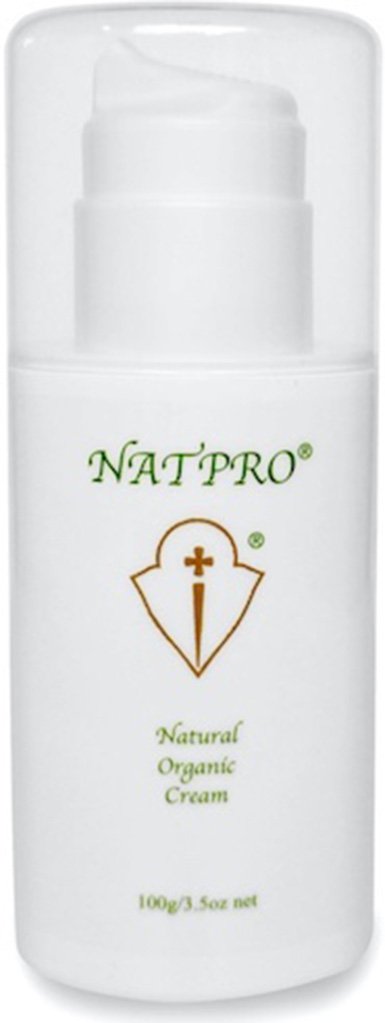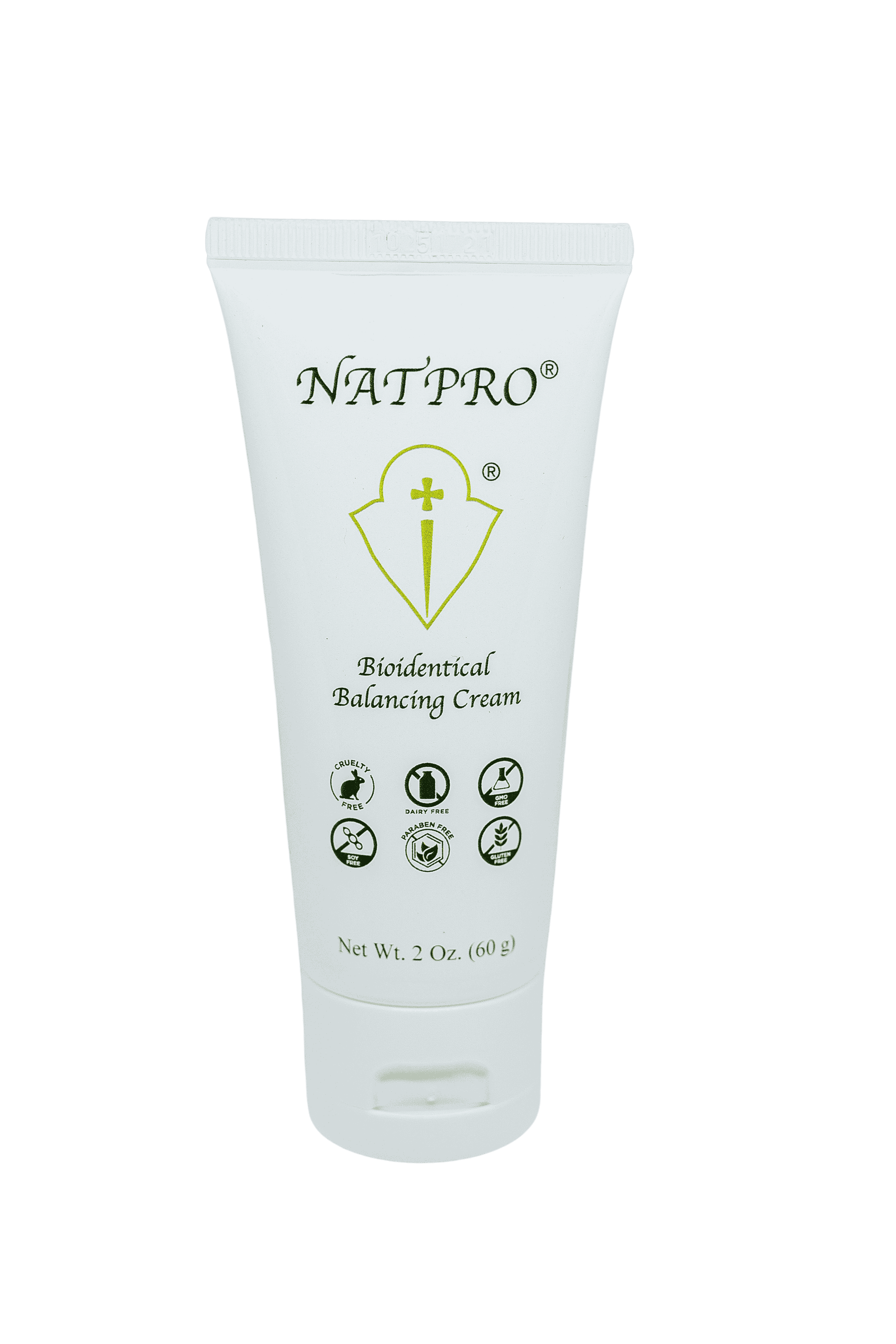Does progesterone therapy get rid of Endometriosis?
Research indicates that insufficient progesterone is made in someone with endometriosis and that the luteal phase is shorter than normal. In some cases the endometrium doesn't respond to progesterone stimulus from the ovaries, in which case a high dose of supplemental progesterone is needed.
Giving supplemental progesterone can help to overcome this problem. The dose required is sometimes quite high to overcome this resistance. Normally a dose between 100-200mg/day of progesterone is sufficient, which equates to 3-6ml/day of Natpro. The higher dose should be used to start with. In severe cases a dose higher than 200mg will be needed, it's best to go by symptoms, adjusting it higher or lower as the weeks go by.
If there is a cycle, use the cream for the last fourteen days only, ie from ovulation to bleeding. If there is no cycle, or an erratic one or the pain is severe, it's best to use the cream daily for the first two to three months, rubbing it over the painful areas. If the symptoms have responded to the progesterone, a cycle can be restarted by using the cream on a cyclic basis, ie stop using the cream. Bleeding should occur shortly after this, resume again on day 15 and use it for the next 14 days. Although this gives a 28 day cycle, it's something to go on while the body adjusts to the natural cycle length. Once ovulation has begun again, start using the cream from this point on for the next 14 days.
Endometriosis is one of the hardest conditions to solve. Progesterone does help the pain in some women, not all. Recent research has found endo is caused by oxidative stress, so huge amounts of antioxidants are needed, in particular N-acetyl cysteine and vitamin D. Cysteine is the rate limiting factor in the cell manufacture of glutathione, probably the most important antioxidant we make. At least 5000mg/day is needed. The other two aminos needed to make glutathione are glycine and glutamine. These are normally abundant in our diet, but when under stress not enough glutamine can be converted, so it's best to take up to 8000mg/day. If possible have a GSH:GSSG test done, this shows whether sufficient glutathione is being made. If not possible then take the three precursor amino acids: N-acetyl cysteine, glutamine and glycine, in particular cysteine.
Have a vitamin D test done. There is now a pandemic of vitamin D deficiency. Over 50% of us have too low a level. It all started when we were told to stay out of the sun and use sunscreens! It's best to take a min of 5000IU's/day, if a severe deficiency is found 10000IU's are needed. For more information see these sites Grassroots Health and Vitamin D Society.
The normal treatment for endo are the progestins, but they have serious side affects.
Endometriosis affects approximately 20% of women worldwide during the years from puberty to menopause, rarely after.
The endometrium is found growing in places other than the uterus. It is most often found in the pelvic area, on the ovaries, Fallopian tubes, the back and front of the uterus, the intestines and the bladder. But it has also been found in the eye, brain, lungs, diaphragm and skin. As the cells within the endometrium in the uterus swell and grow with the rise of oestrogen in the first part of the cycle, so do all the misplaced endometrial cells, giving rise to pain, from mild to extremely severe. Other symptoms are lower back pain, painful sex, painful bowel movements or pain when urination, spotting between periods, fatigue and infertility.
Although no one knows the cause research has found the following markers...
- The interval between the LH peak and the onset of subsequent menstruation is shorter in patients with endometriosis
- In mild, moderate and severe endometriosis the plasma progesterone concentration does not rise on the first day following the LH peak
- Endometriosis has been associated with corpus luteum inadequacy and abnormalities of luteal phase progesterone secretion
- That oestrogen treatment of human endometrial tissue in organ culture maintains secretion of matrix metalloproteinases (MMP), and promotes establishment of ectopic peritoneal lesions. In contrast, suppressing metalloproteinase secretion in vitro with progesterone treatment, a natural inhibitor of metalloproteinases, inhibits the formation of ectopic lesions in experimental models
- It has been shown that 2,3,7,8-tetrachlorodibenzo-p-dioxin (TCDD or dioxin) exposure promotes establishment of experimental endometriosis by interfering with the ability of progesterone to suppress endometrial MMP expression
- Estrogen-associated growth factors as well as inflammatory cytokines are potent stimulators of MMP expression and may contribute to the ability of endometrial fragments to invade the peritoneal surface and establish ectopic sites of growth. In contrast, paracrine factors associated with progesterone action during early pregnancy inhibit MMP expression and prevent ectopic endometrial growth
- Endometriosis, the presence of endometrial tissue outside the uterus, is a progressive, estrogen-dependent disease and occurs nearly exclusively in menstruating women of reproductive age
- Estrogen is an extremely potent mitogen for endometrium and endometriosis. Progesterone, on the other hand, inhibits the mitogenic action of estrogen on endometrium and enhances differentiation. These antiproliferative and differentiative effects of progesterone are less pronounced on endometriosis tissue compared with endometrium. Thus, endometriosis is, at least in part, resistant to progesterone action
- Aromatase P450 is the key enzyme for biosynthesis of estrogen, which is an essential hormone for the establishment and growth of endometriosis
- Progesterone must be considered a potential physiological inhibitor of glucocorticoid-dependent aromatase induction in adipose tissue. It is proposed that it is a suppressor of aromatase induction in adipose tissue in premenopausal women
- One study reported the successful treatment of severe endometriosis in premenopausal women with the aromatase inhibitor anastrozole combined with 200-mg oral progesterone, rofecoxib, and calcitriol. Treatment resulted in a rapid elimination of symptoms and was well tolerated in both cases
The enzyme aromatase converts androstenedione to estrone and testosterone to estradiol. It's found in the brain, endometrium, endometriosis tissue, fibroids, ovaries, placenta, testes, also in breast and endometrial cancer.
It's activity is increased by alcohol, age, cortisol, insulin and obesity amongst others, and decreased by progesterone.
Two theories have been proposed for the cause of endometriosis...
- Endometrial cells migrate up the Fallopian tubes and embed in the pelvic area. Somewhat lacking in validity, as it cannot explain how migrating cells can be found in the brain, lungs, skin etc.
- Another line of research believes the problem starts as the foetus is forming in the uterus. Exposure to too much oestrogen, either endogenous or xeno-oestrogens, causes some endometrial cells to be deposited in other areas, instead of in the endometrium where they should be. When the child reaches puberty they of course develop too, with the resulting problems.
Treatment usually takes the form of anti-inflammatories (see here for an anti inflammatory formula), aromatase inhibitors, continuous hormonal contraception to prevent the monthly bleed, surgical interventions, drugs which stimulate the production of gonadotropin releasing hormone, which causes a severe drop in both oestrogen and progesterone, resulting in possible menopausal symptoms and osteoporosis.
If a woman is nearing menopause they are usually advised to wait, as with the decline in oestrogen the endometrial tissue is no longer stimulated and the pain subsides too.
Additional information
Progesterone
Use 100-200mg progesterone per day. If symptoms are severe, and pain is present, 500mg/day or more will be needed.
Nutrition
Please see here for detailed information... Nutrition and Diet
Endometriosis symptoms
References
Am J Pathol. 2009 Jul;175(1):225-34
Reactive oxygen species controls endometriosis progression
Journal of the Society for Gynecologic Investigation, Vol. 13, No. 6, 390-398 (2006)
Female Infertility and Free Radicals: Potential Role in Adhesions and Endometriosis
Annals of the New York Academy of Sciences 955:139-146 (2002)
Paracrine Mediators of Endometrial Matrix Metalloproteinase Expression
Fertil Steril. 2009 Jul;92(1):328-43
Melatonin and the ovary: physiological and pathophysiological implications
Indian Journal of Biochemistry & Biophysics, 2009 Vol 46, pp 59-65
Curcmin arrests endometriosis by downregulation of MMP9 activity
The FASEB Journal. 2008;22:1189.1
The pathophysiology of intestinal endometriosis is exacerbated by uncontrollable stress
J Steroid Biochem Mol Biol. 2007 Mar;103(3-5):771-5
Expression of 25 hydroxyvitamin D3-1alpha-hydroxylase in human endometrial tissue
Ann N Y Acad Sci (2005) 1042: 186-94
Oxidative damage and mitochondrial DNA mutations with endometriosis
Angiogenesis Volume 8, Number 2 / April, 2005
Vascular development in endometriosis
J Nutr. 2004 Mar;134(3):489-92
Glutathione metabolism and its implications for health
Biomedecine & Pharmacotherapy Volume 57, Issues 3-4, May 2003, Pages 145-155
The importance of glutathione in human disease
Journal of Reproductive Immunology 1999, Volume 44, Issues 1-2, September 1999, Pages 1-27
Menstruation: induction by matrix metalloproteinases and inflammatory cells
Mol Genet Metab. 1999 Jun;67(2):100-5
Glutamine, as a precursor of glutathione, and oxidative stress
The Journal of Clinical Endocrinology & Metabolism 1997, Vol. 82, No. 5 1409-1415
Production of Endometrial Matrix Metalloproteinases, but Not Their Tissue Inhibitors, is Modulated by Progesterone Withdrawal in an in Vitro Model for Menstruation
American Journal of Pathology. 2009;175:225-234 Reactive Oxygen Species Controls Endometriosis Progression
Medscape : March 16, 2007
Pine Bark Extract Reduces Symptoms of Endometriosis
Journal of the Society for Gynecologic Investigation, Vol. 13, No. 6, 390-398 (2006)
Female Infertility and Free Radicals: Potential Role in Adhesions and Endometriosis
Angiogenesis Volume 8, Number 2 / April, 2005 Vascular development in endometriosis The FASEB Journal. 2008;22:1189.1.)
Menopause. 12(2):232-237, March/April 2005.
Percutaneous administration of progesterone: blood levels and endometrial protection
Fertility and Sterility Volume 81, Issue 5 , May 2004, Pages 1395-1398
Successful treatment of severe endometriosis in two premenopausal women with an aromatase inhibitor
The Journal of Clinical Endocrinology & Metabolism
2000, Vol. 85, No. 8 2897-2902
Progesterone Receptor Isoform A But Not B Is Expressed in Endometriosis
Gynecologic and Obstetric Investigation 1999;48:45-56
The Potential Role of Environmental Toxins in the Pathophysiology of Endometriosis
Steroids Volume 64, Issue 9 , September 1999, Pages 648-653
Progesterone and transforming growth factor-b coordinately regulate suppression of endometrial matrix metalloproteinases in a model of experimental endometriosis
J. Clin. Invest. Volume 99, Number 12, June 1997, 2851-2857
Suppression of Matrix Metalloproteinases Inhibits Establishment of Ectopic Lesions by Human Endometrium in Nude Mice
Br J Obstet Gynaecol. 1978 Apr;85(4):246-50.
A study of plasma progesterone, oestradiol-17beta, prolactin and LH levels, and of the luteal phase appearance of the ovaries in patients with endometriosis and infertility
How to best absorb progesterone
A good skin cream (such as Natpro) is the most user friendly of all the ways progesterone can be taken. Oral progesterone is a waste as 80-90% is destroyed in the digestive system and liver. Injections are inconvenient and painful. Buccal drops or pills are very bitter and suppositories are not much fun!
The cream can be applied anywhere... in the vagina or nose for dryness, on piles or painful, achy or itchy areas. Its the best thing for burns and wonderful on the face and elsewhere.
All the successful studies done on progesterone use between 100mg to 200mg per day. This equates to 3ml to 6ml of Natpro per day. Some authorities suggest as high as 400-600mg/day. Orally administered forms need 5 to 10 times as much to compensate for the digestive losses. The cream is best applied twice a day, to keep levels up.

